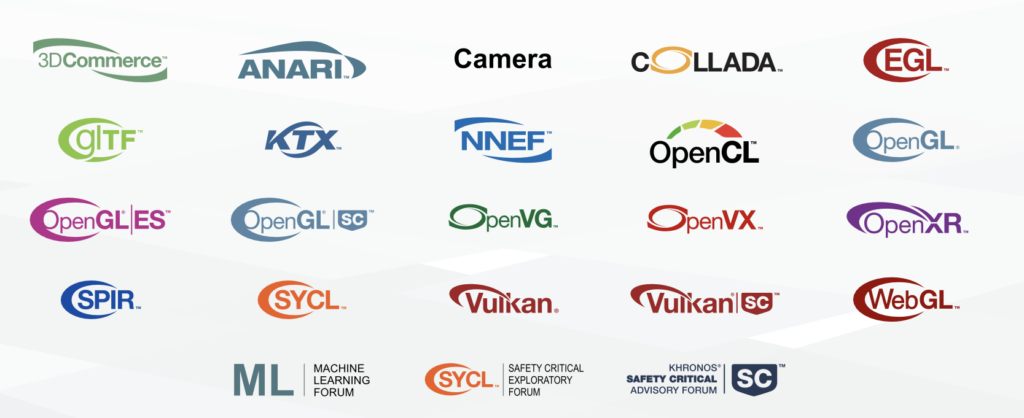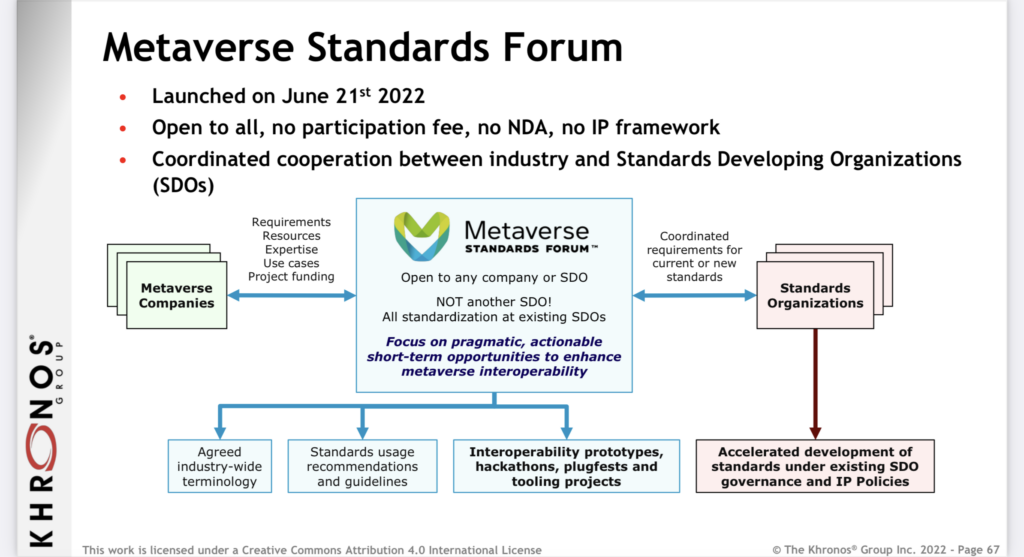The coming Metaverse demands industry segments, companies, standards bodies, and humans work together to define and enable interoperability. ASWF and Khronos are just one example.
We may think of Siggraph as a showcase for splashy movie effects, showy content creation apps, video software, and video graphics pioneers—and it is—but off in the side rooms, over drinks and again with coffee, Siggraph is where progress is made. One example is the USD story; originally, Pixar’s common format to enable content exchange, Universal Scene Description, was opened up in 2016. As a working format, USD has always had broad support, but the effort to make it “the HTML of the future Web” requires much more work to make it transportable across browsers, translatable across engineering software… well, truly universal. It has grown and coalesced with support from Nvidia, Pixar, Unreal, Autodesk, Foundry, and not the least, Khronos.
Early in its life, Khronos concentrated on standards for the mobile industry, but 3D graphics is a central part of its DNA, with OpenGL and its lightweight cousin, OpenGL/ES, being one of founding standards the organization used as its platform. Since then, Khronos is a unifying force for complex industry-wide agreements.

The Academy Software Foundation is another organization that seeks to nurture, maintain, and protect industry standards. Founded in 20I8, ASWF comes out of the film and video industry. The organization works directly with content creators and takes on technology when it’s close to reaching industry acceptance. The ASWF brings interested developers and working professionals together to nail down the details and establish the standard. Many of their standards open the door to continued innovation. Their established portfolio includes:
OpenVDB for manipulating sparse dynamic volumes used by visual effects studios to create realistic volumetric images such as water/liquid simulations and environmental effects like clouds and ice.
OpenColorIO industry standard for consistent color management across VFX and animation pipelines used on hundreds of feature film productions. It touches nearly every pixel of every visual effects frame in most major motion pictures.
OpenEXR is a standard HDR image file format for high-quality image processing and storage, one of the foundational technologies in computer imaging.
OpenCue is an open-source render management system used to break down complex jobs into individual tasks.

The organization is also working on considerably more “incubating projects” including:
OpenTimeLineIO for editorial timelines in software and production;
Open Shading Language (OSL), a de facto standard shading language for VFX and animation;
MateriaIX for exchanging rich material and look development content across applications and renderers;
Rez, an open-source packaging technology for incorporating content from third-party and proprietary products into content environments;
DPEL, the Digital Production Example Library contains sample assets that content creators can use for instructional purposes;
RawtoACES conversion software that converts digital camera RAW files to ACES container files consistent with the Academy Color Encoding Specification (ACES).
The Academy Software Foundation and Khronos clearly have interests in common, but they also have clearly defined territories and different approaches to incorporating standards. Khronos tends to invite all interested parties in and let everyone hash it out. The ASWF, which is defined by the critical boundaries of budgets and deadlines, is much more deliberate in its processes.
Nevertheless, Khronos has announced they’re joining the ASWF. Also, and not to be downplayed, Ubuntu’s parent company, Canonical, has also joined the ASWF. The involvement of Canonical is also a natural collaboration, since the ASWF was originally launched by the Academy of Motion Picture Arts and Science and the Linux Foundation. So much of the development work done in the film industry is accomplished using Linux. Canonical calls Ubuntu the number one operating system in the public cloud. In addition to development tools, Canonical provides security, support, and services. Canonical says its aim for media and entertainment to make open source a first-choice solution for creative professionals. Ubuntu Server provides a path for sharing workloads, scaling production, and distributing content. Canonical joined Khronos in 2014.
Khronos president Neil Trevett says the organization members are looking forward to sharing information with “the experts in the ASWF membership.” Specifically, they think there is interesting work to be done on MaterialX and fostering closer coordination with Khronos’ standards such as glTF, OpenXR, and Vulkan.
Both groups are also members of the new Metaverse Standards Forum.
What do we think?
The standards bodies have always been interested in their mutual work. The evolution of Web 3.0 and the Metaverse demands that standards body do more than be polite to each other. Rather, it’s becoming obvious and necessary that standards be developed broadly and not within industry silos. For instance, in his talk for Siggraph 2022, Jensen Huang mentioned that the Khronos glTF standard and USD are going to have to come together in some ways. The glTF standard carries information for objects and environments, enabling them to be placed correctly in a location or to have objects or characteristics placed on them—textures, for instance, and buildings correctly oriented within their geolocation.
Khronos’ presentation on glTF and the metaverse addressed this issue and presents the Metaverse Standards Forum as something like a meta-standards body. It is an effort to coordinate the development of standards pertinent to creating metaverses.

Personally, the constant talk of “the” metaverse drives me nuts. We don’t know that there’s going to be one metaverse; we’re having a pretty hard time holding the real world together. The idea of one metaverse seems a signal for different entities to try and claim ownership of said metaverse, and we all know who the major contenders are and where the sticking points will be. This world has a lot of magnetic poles, including Apple, Epic, Google, Microsoft, and Nvidia, to name a few.
However, Khronos has had good luck so far bringing disparate interests together and somehow negotiating through territorial issues. The idea of a coalition of standards bodies isn’t just a good idea, it’s necessary. Khronos’ Trevett told Wired magazine that “a truly successful standard becomes so ubiquitous, you forget that it’s actually a standard at all.” Staying in the background has been Khronos’ super-power. Let’s see if they can sustain it.





